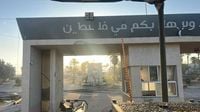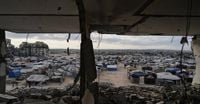After months of anticipation and mounting humanitarian pressure, the Rafah border crossing between Gaza and Egypt is set to partially reopen on Monday, October 20, 2025, the Palestinian embassy in Egypt announced this weekend. For thousands of Palestinians stranded outside their homeland, the move offers a rare window of hope, though the crossing will remain closed to those seeking to exit Gaza—a limitation that underscores the ongoing complexity of the region’s crisis.
The Rafah crossing, Gaza’s only gateway to the outside world not controlled by Israel prior to the war, has been largely shuttered since May 2024. That’s when Israeli forces seized control of the Gaza side, effectively cutting off a critical lifeline for civilians desperate for medical care, family reunification, or simple respite from the relentless hardships of conflict. According to the Palestinian embassy, the number of people registering to return to Gaza is "very big," reflecting both the scale of displacement and the urgency of the need.
Yet, as reported by The Associated Press and Free Malaysia Today, there’s no sign that the crossing will allow the flow of humanitarian aid or let people leave Gaza anytime soon. The embassy’s statement was silent on whether food, medicine, or other supplies would be permitted through Rafah. For now, the reopening is strictly for Palestinians returning home—a bittersweet development for a population whose needs extend far beyond the ability to cross a border.
The reopening comes amid a fragile ceasefire, brokered by the United States, that took effect on October 13, 2025. This truce ended two years of devastating war in Gaza, a period marked by bombardment, blockade, and a humanitarian disaster that has drawn international outcry. According to Gaza’s Health Ministry, over 68,000 Palestinians have died since the conflict began. The ministry, which is part of the Hamas-run government, does not differentiate between civilians and combatants in its tally, but its casualty records are considered generally reliable by United Nations agencies and independent experts. Israel disputes these numbers, though it has not provided alternative figures.
The scale of devastation is staggering. As reported by Breaking News, the ruins of Gaza are still being combed for the dead, more than a week into the ceasefire. Newly recovered bodies have pushed the Palestinian death toll even higher, while thousands remain missing, according to the Red Cross. The destruction has also hampered efforts to retrieve the remains of Israeli hostages held by Hamas—a central demand of Israel and a key sticking point in the ceasefire agreement.
On October 18, 2025, Israeli officials identified the remains of Eliyahu Margalit, a 76-year-old Israeli abducted by Hamas on October 7, 2023. Margalit, who was taken from the horse stables where he worked in Kibbutz Nir Oz, is the tenth hostage whose body has been returned since the ceasefire began. The Israeli prime minister’s office confirmed that Margalit’s body was identified after testing by the National Centre for Forensic Medicine, and his family has been notified. The return of his remains brings some solace to his loved ones, but as the Hostage Forum—a group supporting the families of abductees—emphasized, "they will not rest until the remaining 18 hostages come home." The forum has vowed to continue holding weekly rallies until all remains are returned.
Hamas handed over an 11th body this week, though it was not that of a hostage. The group insists it is committed to the terms of the ceasefire deal, including the handover of bodies, but the process is fraught with challenges. The devastation in Gaza, coupled with the presence of unexploded ordnance and the fact that some bodies are in areas controlled by Israeli troops, has made retrieval perilous and slow. US President Donald Trump has warned that if Hamas fails to return all hostages’ bodies—28 in total—he would green-light Israel to resume the war, adding further tension to an already fraught situation.
The ceasefire was also supposed to bring a surge of humanitarian aid into Gaza, but so far, the flow has fallen short of agreed targets. United Nations data shows that since the truce began, only 339 aid trucks have been offloaded for distribution in Gaza—well below the 600 trucks per day stipulated in the ceasefire agreement. The UN World Food Programme reports that around 560 metric tonnes of food have entered Gaza daily on average since the ceasefire, but this is still far from meeting the overwhelming scale of need.
Much of the aid that does arrive comes through the Israeli crossing at Kerem Shalom, about three kilometers south of Rafah. Aid workers and truck drivers have complained of a host of obstacles at Kerem Shalom, ranging from rejections over minor packing and paperwork issues to limited operating hours. As a result, only a fraction of the required aid is making it to those who need it most. Israel, for its part, denies that it has limited aid into Gaza, stating that it has allowed in enough food and accusing Hamas of stealing much of it—a claim that UN agencies and other humanitarian organizations flatly deny.
The consequences of these constraints are dire. In March 2025, Israel launched an 11-week blockade of all aid into Gaza, causing food stockpiles to dwindle and prices to soar. By August, a global hunger monitor declared famine was unfolding in Gaza City, particularly in the enclave’s north. Gaza’s health authorities report that over 400 people have died from malnutrition-related causes, including more than 100 children. Israel has dismissed these findings as "false and biased," arguing that many of the deaths were attributable to other causes. However, the United Nations and other aid agencies have verified the malnutrition-related deaths, underscoring the gravity of the crisis.
For Gaza’s more than two million residents, the partial reopening of Rafah is a small step toward normalcy, but it falls far short of what is needed. The territory’s battered infrastructure, ongoing restrictions on aid, and the slow pace of reconstruction leave most Gazans facing daily struggles for survival. The United Nations Relief and Works Agency (UNRWA), the largest humanitarian organization in Gaza, has called for unimpeded access to carry out its work. As of mid-October, over 8,000 UNRWA teachers stand ready to help children return to school and resume their education—another reminder of the urgent need for stability and support.
Meanwhile, political leaders and mediators continue to press for broader solutions. Hamas has urged mediators to expedite the opening of Rafah for aid and reconstruction, while Israel insists on the return of all hostages’ remains. The international community, for its part, watches closely, hoping that the fragile ceasefire and the tentative reopening of Rafah might signal the start of a more lasting peace—and, perhaps, a path out of the humanitarian catastrophe that has engulfed Gaza for far too long.
As the border opens to returning Palestinians on Monday, the world will be watching for signs of progress—and for the long-awaited relief that Gaza’s people so desperately need.


